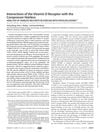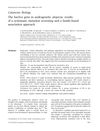18 citations
,
October 2009 in “Endocrinology” 62 citations
,
January 2009 in “Biochemistry” Vitamin D receptor binds similarly to natural and synthetic ligands, affecting gene regulation.
1 citations
,
July 2007 in “Journal of Investigative Dermatology”  42 citations
,
July 2007 in “Journal of Biological Chemistry”
42 citations
,
July 2007 in “Journal of Biological Chemistry” Most Hairless gene mutations reduce its ability to work with the Vitamin D Receptor, which might explain a certain type of hair loss.
18 citations
,
February 2006 in “Genomics” 78 citations
,
November 2005 in “Endocrinology” Hairless protein can block vitamin D activation in skin cells.
144 citations
,
December 2004 in “Molecular Endocrinology” 67 citations
,
August 2004 in “Endocrinology” A specific gene mutation causes vitamin D resistance, but certain vitamin D analogs might help.
215 citations
,
September 2003 in “Journal of Biological Chemistry” Vitamin D receptor and hairless protein are essential for hair growth.
20 citations
,
August 2003 in “Clinical and Experimental Dermatology” Atrichia with papular lesions (APL) was identified as a rare autosomal recessive disorder characterized by complete and irreversible hair loss shortly after birth, along with the development of papular lesions of keratin-filled follicular cysts. This study reported a novel missense mutation, E583V, in the hairless gene in an Italian family affected by APL. The mutation was located between the LXXLL motif in exon 5 and the zinc-finger motif in exon 6, regions that were highly conserved across several species. This finding contributed to the understanding of the critical role of these domains in the function of the hairless protein and highlighted the occurrence of APL in small, non-consanguineous families globally.
26 citations
,
October 2002 in “Journal of Investigative Dermatology” A specific gene mutation causes congenital hair loss.
 15 citations
,
April 2002 in “British Journal of Dermatology”
15 citations
,
April 2002 in “British Journal of Dermatology” Hairless gene not strongly linked to baldness.
137 citations
,
April 2001 in “Journal of Clinical Investigation” 303 citations
,
October 2000 in “Nature” 66 citations
,
December 1999 in “Journal of Investigative Dermatology”

